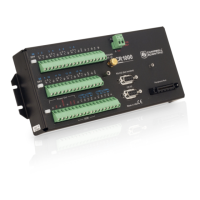Note Error discussed in this section and error-related specifications of the
CR1000 do not include error introduced by the sensor or by the transmission of
the sensor signal to the CR1000.
The accuracy specifications for ratiometric-resistance measurements are
summarized in the tables Ratiometric-Resistance Measurement Accuracy
(p. 342).
Table 72. Ratiometric-Resistance Measurement Accuracy
–25 to 50 °C
±(0.04% of voltage measurement + offset)
1
1
Voltage measurement is variable V
1
or V
2
in the table Resistive-Bridge Circuits with Voltage
Excitation
(p. 338). Offset is the same as that for simple analog-voltage measurements. See the
table Analog-Voltage Measurement Offsets
(p. 313).
Assumptions that support the ratiometric-accuracy specification include:
• CR1000 is within factory calibration specification.
• Excitation voltages less than 1000 mV are reversed during the excitation
phase of the measurement.
• Effects due to the following are not included in the specification:
o Bridge-resistor errors
o Sensor noise
o Measurement noise
For a tighter treatment of the accuracy of ratiometric measurements, consult the
technical paper Estimating Measurement Accuracy for Ratiometric Measurement
Instructions., which should be available at www.campbellsci.com/app-notes
(http://www.campbellsci.com/app-notes) in June of 2015.
8.1.2.5 Strain Measurements — Details
Related Topics:
• Strain Measurements — Overview (p. 68)
• Strain Measurements — Details
(p. 342)
• FieldCalStrain() Examples
(p. 223)
A principal use of the four-wire full bridge is the measurement of strain gages in
structural stress analysis. StrainCalc() calculates microstrain (µε) from the
formula for the particular strain bridge configuration used. All strain gages
supported by StrainCalc() use the full-bridge schematic. In strain-gage parlance,
'quarter-bridge', 'half-bridge' and 'full-bridge' refer to the number of active
elements in the full-bridge schematic. In other words, a quarter-bridge strain gage
has one active element, a half-bridge has two, and a full-bridge has four.
StrainCalc() requires a bridge-configuration code. The table StrainCalc()
Instruction Equations
(p. 343) shows the equation used by each configuration code.
Each code can be preceded by a dash (-). Use a code without the dash when the
bridge is configured so the output decreases with increasing strain. Use a dashed
code when the bridge is configured so the output increases with increasing strain.
In the equations in table StrainCalc() Instruction Equations
(p. 343), a dashed code
342

